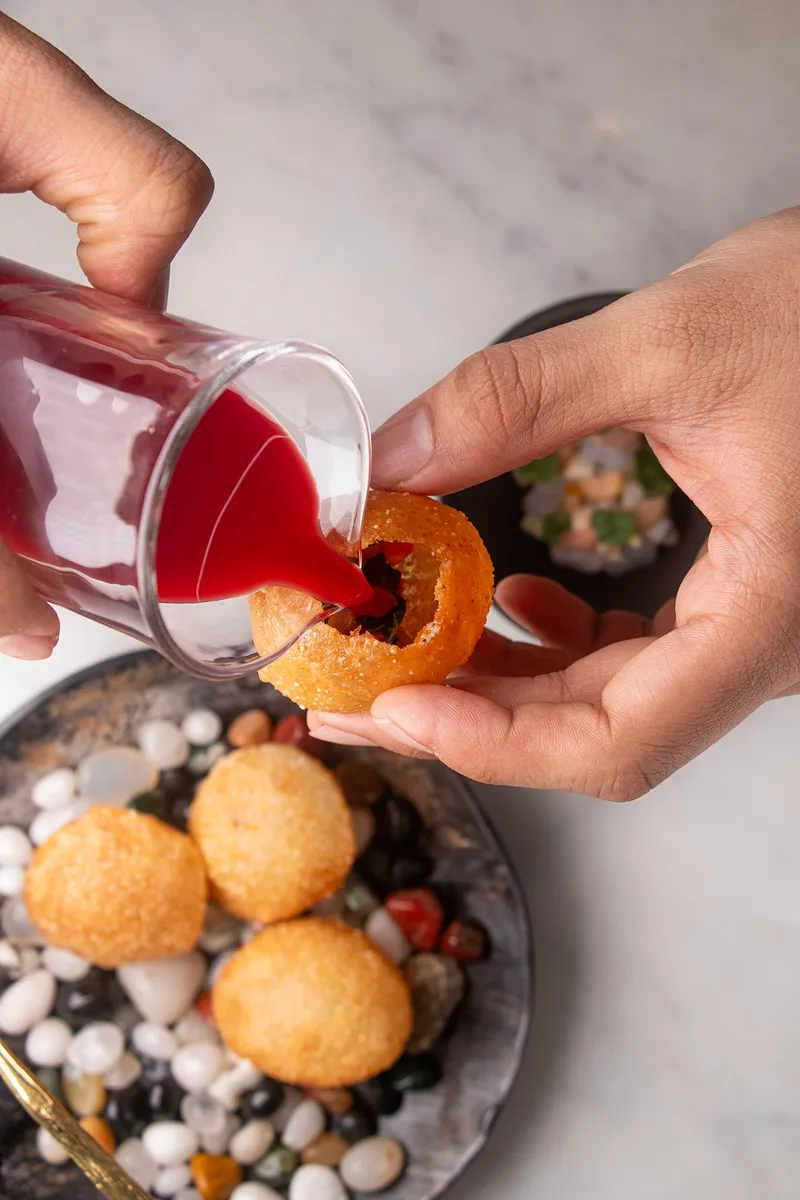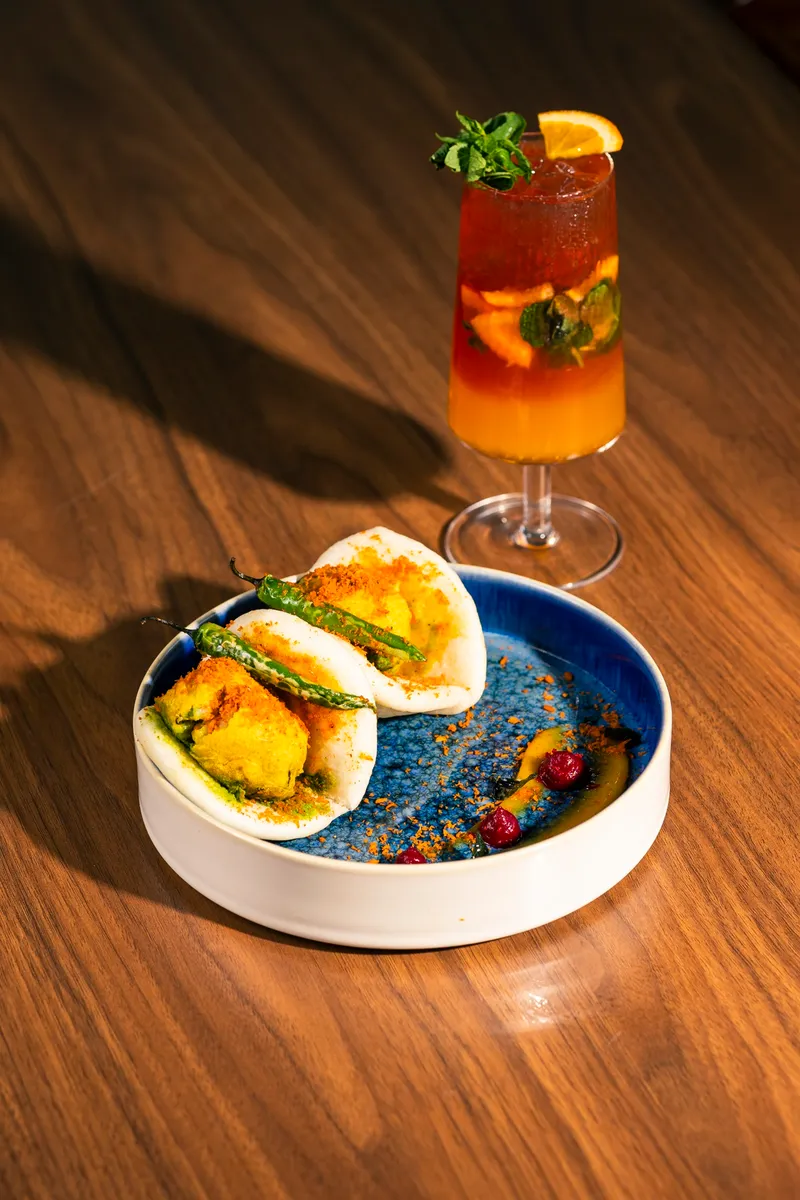From Indian streets to fine dining restaurants, chaats go global
Once considered a street food staple, chaats are slowly but steadily becoming a part of menus in fine dining restaurants. Is it a passing phase or is the trend here to stay?
As a child, every summer meant heading to my nani's home from Delhi to Kolkata. While the afternoons were spent indoors escaping the sultry heat, the evenings brought in the excitement of stepping out and enjoying the street food available in the neighbourhood. My cousins and I would stand patiently at the puchka cart, relishing as many crispy fried puffed balls filled with potato and flavoured water.
Cut to today, most of my recent chaat-experiences have been at fine dining restaurants. The humble Indian street food has gotten premium with interesting twists such as the pani puri with seabuckthorn at Mumbai’s Masque, and the Jhalmuri Posto Chaat at IHCL’s Yellow House in Anjuna, Goa.
From hygiene and presentation to creativity, everything was spot on. After all, elevating the humble chaat to a fine dining offering is no easy feat.
But here’s the real question: are Indian diners ready for this dining revolution? YS Life speaks to some top restaurants in India to know more.
An elevated twist
At Mumbai’s The Bombay Canteen, with every seasonal menu, the team introduces new chaats, showing their dedication to the idea. This also gives diners an opportunity to look forward to these creations.

Creamed burrata papdi chaat at Taupe by Titlie, Goa
For instance, its twist on the classic chaat favourite, ragda pattice with seasoned, crisp fried banana tikki with a medley of radish salad, pomegranate, and tangy amchur chutney, has a growing tribe of loyalists.
Chef Hussain Shahzad, who is at the helm of this award-winning restaurant, believes eating chaat is a multi-sensory experience, so why not have it on The Bombay Canteen menu?
“Including chaat dishes in restaurant menus also builds cultural pride and helps people appreciate Indian cuisine. Our creation of a plethora of chaat dishes, inspired by various regions in India, showcases our country’s culinary diversity,” shares Chef Shahzad, Executive Chef, Hunger Inc. Hospitality (The Bombay Canteen, O Pedro, Veronica’s, and Papa’s).
Agrees Chef Manish Mehrotra, Culinary Director at Indian Accent New Delhi, New York and Mumbai. At Indian Accent, the team has gone the extra mile to curate a dedicated chaat-tasting menu that elevates the street food while keeping its essence intact.
“It shouldn't be a vague, wild fusion where people can't even identify what they are eating. So, for example, we have a potato spear chaat where every element of the chaat is present. The only difference is that instead of using a crisp aloo tikki, we have made potato spears that are crispier and more caramelised,” Chef Mehrotra tells YS Life.

Red tamarind pani puri, with chewy beets and barramundi, at Masque
The pani puri is another offering that many restaurants are experimenting with. Almost two decades ago, Punjabi by Nature in Delhi introduced golgappa shots with vodka. Today, there are many more versions.
Masque, helmed by Aditi Dugar and Varun Totlani, has done a few iterations of the pani puri, most recently with a filling of either cured barramundi or chewy beets, aam papad and gooseberry, with a pani made of red tamarind.
While Totlani is hesitant to call these offerings ‘elevated’, he believes chaats lend themselves easily to reinterpretation, which is why they are now easily found in fine dining restaurants.
Interestingly, Chef Tarun Sibal believes that the best food is available on the street and it isn't easy for restaurateurs to beat that. However, there is room to have ‘street special’ in a fine dining setup—a term that came to the fore when ‘modern Indian' was coined.
At his restaurant in Goa, Taupe by Titlie, the Creamed Burrata Papdi chaat with achar purée, jalapeno, amchur, and sev, takes the cake. There's also the humble palak patta chaat where Sibal has replaced the spinach with micro greens that are flash fried in tempura batter and served with dried berries, homemade chaat masala, and sweetened yoghurt.
“Something like this works because you are giving your audience flavours that they have grown up with but with a completely different approach,” he reiterates.
On the world stage
The trend of elevating street food is also helping take Indian chaats global. In 2022, Chef Manav Tuli-led restaurant CHAAT in Hong Kong received its first Michelin star for adding a creative twist to chaats.
“Elevating chaat is a winning streak for global diners. The variety, familiar ingredients, and vibrant presentation offer an accessible and perfect entry to Indian cuisine. Modern twists and high-quality ingredients can cater to a broader audience, making chaat an ambassador for Indian flavours,” believes Shikha Nath, Culinary Director, Bombay Brasserie.

Potato spear chaat with white peas mash at Indian Accent
In Mehrotra’s opinion, elevating chaats is the best way to go places. That's also because not everyone has access to street food, nor will everyone go out and explore these offerings on the street.
“If it remains on the streets, it will never reach the world. When you elevate it a little, while keeping its essence intact and serving it in a restaurant, its reach becomes international. More and more people from around the world can try it, relate to it, and it will become more popular,” he says.
Similarly, journalist and author Sonal Ved believes that exposure and affiliation to any cuisine or a style of cooking that has worked in its basic format will certainly invoke a certain kind of curiosity in the diner to taste it in a more evolved manner.
“Indian cuisine, on the whole, is experiencing a shift and a new narrative, and these glamorous chaats are a part of this evolution,” she adds.
In her latest cookbook India Local by Roli Books, Ved has shared recipes of basic chaats like Amritsari Bun Chaat, Rajasthani Mirchi Vada, Banarasi Tamatar Chaat, Indore’s Namkeen Chaat, but also fun things like Cheeseling Bhel, Vitamin Bhel, Barley and Couscous tikki, Mango Cream, Papdi ‘Lasagna’ with orange yoghurt, Quinoa and olive tikki Chaat, Burrata Papdi Chaat and more.

Jijabai vada pao at Te Amo
“There is room to present Indian chaats to global diners as is, in its full glory, and then also elevate the experience and make the presentation and form at par with haute cuisine. But crediting the source and sticking to real flavours is necessary so the focus stays on Indian cuisine and isn't confused,” reiterates Ved.
Is it here to stay?
All in all, restaurateurs and chefs believe the trend of chaats in fine dining menus is here to stay. Elevating chaats is a good way to innovate the offering and at the same time, showcase the wealth of Indian cuisine.
“It also offers us an opportunity to create and curate memorable dining experiences for guests. At the same time, it's also a good way to preserve the essence of these beloved street foods and celebrate the richness and diversity of Indian culinary traditions,” mentions Anirudh Deshpande, Executive Chef, The Westin Goa.
At the same time, it also breaks the stereotype that Indian food is only about curries and rice, showcasing the variety and complexity of the cuisine, points out Chef Suvir Saran, Curator, Te Amo Bistro & Bar, Gurugram that includes avocado bhel—a take on the traditional bhel puri with the inclusion of avocado–on its menu. There's also Jijabai Vada Bao that combines the concept of a traditional vada pav with coconut and garlic thecha.
However, certain guardrails must be considered when serving chaats in fine dining spaces.
“Elevation should come from technique and presentation style, but ingredients should remain as it is. I think that’s the best way to introduce chaat to a wider audience,” says Saloni Kukreja, Chef, Food Content Creator and Entrepreneur.
Edited by Megha Reddy







